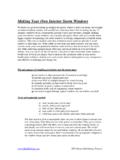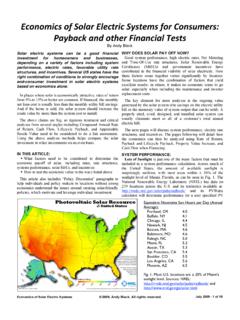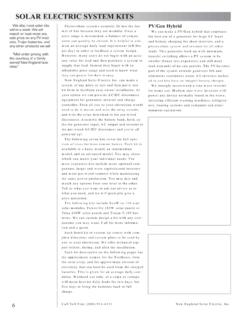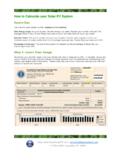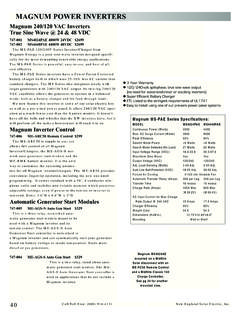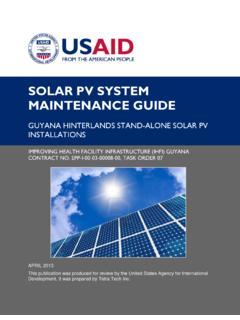Transcription of Solar-Powered Livestock Watering Systems
1 Agricultural Extension Service The University of Tennessee PB 1640. Solar-Powered Livestock Watering Systems Table of Contents Introduction 3. How Does a solar Water Pumping system Work? 3. Photovoltaic Panels 3. solar (DC) Water Pumps 4. Solar-Powered Water Pumping system Configurations 5. Battery-coupled solar Pumping Systems 5. system Components 6. Pump Controller 6. Charge Control Regulators 6. Batteries 6. Direct-coupled solar Pumping system 7. system Component 7. Power Controllers 7. Selecting a Solar-Powered Water Pumping system 8. Cost 8. Livestock Water Requirements 8. Sizing the system 8. Installing the system 10.
2 Mounting PV Panels 10. Wiring 10. Water Delivery system 10. Pump Sets 11. Maintenance 11. Demonstration Systems 12. Appendix A: solar Water Pumping Equipment Suppliers 14. Water 2. Solar-Powered Livestock Watering Systems Michael J. Buschermohle, Associate Professor Robert T. Burns, Assistant Professor Agricultural and Biosystems Engineering Introduction Many Livestock producers allow their animals free access to the rivers, streams and creeks that run through rural Tennessee. Along these surface water sources are areas commonly referred to as riparian zones. A well- vegetated riparian zone establishes a buffer between agricultural land and surface water sources.
3 These buffer strips filter and purify water as it moves across the riparian zone, reduce sediment loads and support soil stability while providing additional benefits such as improved wildlife and fisheries habitat. Over time, allowing Livestock access to these buffer areas can lead to poorly vegetated riparian zones with unstable, erosion-prone stream banks. Livestock producers are hearing more these days about the need to protect water quality through riparian zone management. Allowing the riparian zone to revegetate by removing or limiting Livestock access to these buffer areas is one method of protecting water quality.
4 However, the major problem most Livestock producers face when considering limiting cattle access to riparian zones is that these rivers, streams and creeks are the only water source for their Livestock . Fencing Livestock out of these streams dictates the need for an alternative Watering system . In areas where AC electric power is readily available, an AC- powered pump is by far the best Solar-Powered choice for pumping water from the stream. More often than not, AC Figure 1. Photovoltaic Panels power is not available. Since the stream is generally lower in eleva- tion than the fields bordering the riparian zone, gravity Systems are usually not an option.
5 Several alternative pumping Systems are available, including ram, sling and Solar-Powered pumps. While ram and sling pumps require specific conditions to operate ( , adequate elevation head or stream velocity), solar pumps can be operated at any sunny location within reasonable elevation limits between the Watering tank and water supply. For more information about alternative Livestock Watering options, see PB 1641, Selection of Alternative Livestock Watering Systems . How Does a solar Water Pumping system Work? Photovoltaic Panels A Solar-Powered water pumping system is made up of two basic components. The first component is the power supply consisting of photovoltaic (PV) panels (Figure 1).
6 The smallest element of a PV panel is the solar cell. Each solar cell has two or more specially prepared layers of semiconductor material that produce direct current (DC). electricity when exposed to light. This DC current is collected by the wiring in the panel. It is then supplied either to a DC pump, which in turn pumps water whenever the sun shines, or stored in batteries for later use by the pump. Manufacturers normally rate voltage (volts) and current (amps) output from PV panels under peak power conditions. Peak power (watts=volts x amps) is the maximum power available from the PV panel at 1000 W/m2 solar irradiance (amount of sunshine) and a specified temperature, usually 25 C (77 F).
7 Typical output from a 60-watt PV. panel is shown in Table 1. The amount of DC current produced by a PV panel is much more sensitive to light intensity striking the panel than is voltage generated. Roughly speaking, if you halve the light intensity, you halve the DC. current output, but the voltage output is reduced only slightly. 3. Table 1. Typical output from a 60-watt, 12-volt photovoltaic panel. Maximum Power 60 Watts Maximum Power Voltage Volts Maximum Power Current Amps Individual PV panels can be wired in series or parallel to obtain the required voltage or current needed to run the pump. The voltage output from panels wired in series is the sum of all the voltages from the panels.
8 For example, the maximum voltage output from two of the 12-volt PV panels shown in Table 1 wired in series is volts. Thus, a 24-volt DC pump requires a minimum of two, 12-volt panels wired in series. The current (amps) output from these same panels wired in series is equal to the current (amps) output from an individual panel, amps. The voltage and current output from panels wired in parallel is the exact opposite of series-wired panels. For panels wired in parallel, the current (amps) output is the sum of all the currents (amps) from the panels and the voltage is equal to the voltage output from an individual panel. solar (DC) Water Pumps The other major component of these Systems is the pump.
9 solar water pumps are specially designed to use solar power efficiently. Conventional pumps require steady AC current that utility lines or generators supply. solar pumps use DC current from batteries and/or PV panels. Also, they are designed to work effec- tively during low-light conditions, at reduced voltage, without stalling or overheating. Although a wide range of sizes are available, most pumps used in Livestock - Watering applications are low volume, yielding two to four gallons of water per minute. Low-volume pumping keeps the cost of the system down by using a minimum number of solar panels and using the entire daylight period to pump water or charge batteries.
10 Some solar pumps are fully submersible, while others are not. The use of submersible pumps eliminates potential priming and freezing problems. Most solar water pumps are designed to use solar power most efficiently and operate on 12 to 36 volts DC. Many solar pumping Systems use positive displacement pumps that seal water in cavities inside the pump and force it upward. Their design enables them to maintain their lift capacity all through the solar day at the slow, varying speeds that result from varying light conditions. Positive displacement pumps include piston and jack pumps, diaphragm, vane and screw pumps. Centrifugal-type pumps that impart energy to the water using a rotating impeller are typically used for low-lift or high-volume Systems .


